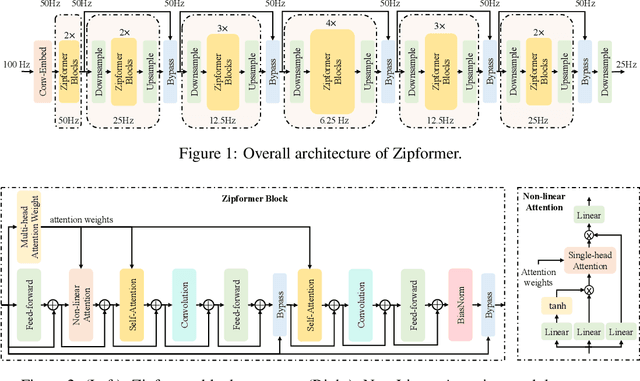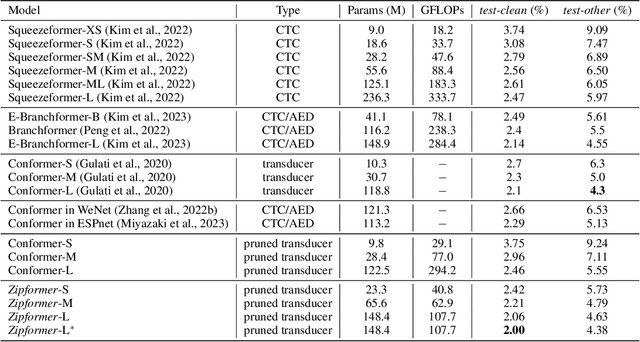Zengwei Yao
TransMLA: Multi-head Latent Attention Is All You Need
Feb 11, 2025Abstract:Modern large language models (LLMs) often encounter communication bottlenecks on current hardware, rather than purely computational constraints. Multi-head Latent Attention (MLA) tackles this challenge by using low-rank matrices in the key-value (KV) layers, thereby allowing compressed latent KV states to be cached. This approach significantly reduces the KV cache size relative to traditional multi-head attention, leading to faster inference. Moreover, MLA employs an up-projection matrix to increase expressiveness, trading additional computation for reduced communication overhead. Although MLA has demonstrated efficiency and effectiveness in Deepseek V2/V3/R1, many major model providers still rely on Group Query Attention (GQA) and have not announced any plans to adopt MLA. In this paper, we show that GQA can always be represented by MLA while maintaining the same KV cache overhead, but the converse does not hold. To encourage broader use of MLA, we introduce **TransMLA**, a post-training method that converts widely used GQA-based pre-trained models (e.g., LLaMA, Qwen, Mixtral) into MLA-based models. After conversion, the model can undergo additional training to boost expressiveness without increasing the KV cache size. Furthermore, we plan to develop MLA-specific inference acceleration techniques to preserve low latency in transformed models, thus enabling more efficient distillation of Deepseek R1.
k2SSL: A Faster and Better Framework for Self-Supervised Speech Representation Learning
Nov 26, 2024Abstract:Self-supervised learning (SSL) has achieved great success in speech-related tasks, driven by advancements in speech encoder architectures and the expansion of datasets. While Transformer and Conformer architectures have dominated SSL backbones, encoders like Zipformer, which excel in automatic speech recognition (ASR), remain unexplored in SSL. Concurrently, inefficiencies in data processing within existing SSL training frameworks, such as fairseq, pose challenges in managing the growing volumes of training data. To address these issues, we propose k2SSL, an open-source framework that offers faster, more memory-efficient, and better-performing self-supervised speech representation learning, with a focus on downstream ASR tasks. The optimized HuBERT and proposed Zipformer-based SSL systems exhibit substantial reductions in both training time and memory usage during SSL training. Experiments on LibriSpeech and Libri-Light demonstrate that Zipformer-based SSL systems significantly outperform comparable HuBERT and WavLM systems, achieving a relative WER reduction on dev-other/test-other of up to 34.8%/32.4% compared to HuBERT Base after supervised fine-tuning, along with a 3.5x pre-training speedup in total GPU hours.
CR-CTC: Consistency regularization on CTC for improved speech recognition
Oct 07, 2024



Abstract:Connectionist Temporal Classification (CTC) is a widely used method for automatic speech recognition (ASR), renowned for its simplicity and computational efficiency. However, it often falls short in recognition performance compared to transducer or systems combining CTC and attention-based encoder-decoder (CTC/AED). In this work, we propose the Consistency-Regularized CTC (CR-CTC), which enforces consistency between two CTC distributions obtained from different augmented views of the input speech mel-spectrogram. We provide in-depth insights into its essential behaviors from three perspectives: 1) it conducts self-distillation between random pairs of sub-models that process different augmented views; 2) it learns contextual representation through masked prediction for positions within time-masked regions, especially when we increase the amount of time masking; 3) it suppresses the extremely peaky CTC distributions, thereby reducing overfitting and improving the generalization ability. Extensive experiments on LibriSpeech, Aishell-1, and GigaSpeech datasets demonstrate the effectiveness of our CR-CTC, which achieves performance comparable to, or even slightly better than, that of transducer and CTC/AED.
LibriheavyMix: A 20,000-Hour Dataset for Single-Channel Reverberant Multi-Talker Speech Separation, ASR and Speaker Diarization
Sep 01, 2024



Abstract:The evolving speech processing landscape is increasingly focused on complex scenarios like meetings or cocktail parties with multiple simultaneous speakers and far-field conditions. Existing methodologies for addressing these challenges fall into two categories: multi-channel and single-channel solutions. Single-channel approaches, notable for their generality and convenience, do not require specific information about microphone arrays. This paper presents a large-scale far-field overlapping speech dataset, crafted to advance research in speech separation, recognition, and speaker diarization. This dataset is a critical resource for decoding ``Who said What and When'' in multi-talker, reverberant environments, a daunting challenge in the field. Additionally, we introduce a pipeline system encompassing speech separation, recognition, and diarization as a foundational benchmark. Evaluations on the WHAMR! dataset validate the broad applicability of the proposed data.
Zipformer: A faster and better encoder for automatic speech recognition
Oct 17, 2023



Abstract:The Conformer has become the most popular encoder model for automatic speech recognition (ASR). It adds convolution modules to a transformer to learn both local and global dependencies. In this work we describe a faster, more memory-efficient, and better-performing transformer, called Zipformer. Modeling changes include: 1) a U-Net-like encoder structure where middle stacks operate at lower frame rates; 2) reorganized block structure with more modules, within which we re-use attention weights for efficiency; 3) a modified form of LayerNorm called BiasNorm allows us to retain some length information; 4) new activation functions SwooshR and SwooshL work better than Swish. We also propose a new optimizer, called ScaledAdam, which scales the update by each tensor's current scale to keep the relative change about the same, and also explictly learns the parameter scale. It achieves faster convergence and better performance than Adam. Extensive experiments on LibriSpeech, Aishell-1, and WenetSpeech datasets demonstrate the effectiveness of our proposed Zipformer over other state-of-the-art ASR models. Our code is publicly available at https://github.com/k2-fsa/icefall.
PromptASR for contextualized ASR with controllable style
Sep 20, 2023Abstract:Prompts are crucial to large language models as they provide context information such as topic or logical relationships. Inspired by this, we propose PromptASR, a framework that integrates prompts in end-to-end automatic speech recognition (E2E ASR) systems to achieve contextualized ASR with controllable style of transcriptions. Specifically, a dedicated text encoder encodes the text prompts and the encodings are injected into the speech encoder by cross-attending the features from two modalities. When using the ground truth text from preceding utterances as content prompt, the proposed system achieves 21.9% and 6.8% relative word error rate reductions on a book reading dataset and an in-house dataset compared to a baseline ASR system. The system can also take word-level biasing lists as prompt to improve recognition accuracy on rare words. An additional style prompt can be given to the text encoder and guide the ASR system to output different styles of transcriptions. The code is available at icefall.
Libriheavy: a 50,000 hours ASR corpus with punctuation casing and context
Sep 15, 2023



Abstract:In this paper, we introduce Libriheavy, a large-scale ASR corpus consisting of 50,000 hours of read English speech derived from LibriVox. To the best of our knowledge, Libriheavy is the largest freely-available corpus of speech with supervisions. Different from other open-sourced datasets that only provide normalized transcriptions, Libriheavy contains richer information such as punctuation, casing and text context, which brings more flexibility for system building. Specifically, we propose a general and efficient pipeline to locate, align and segment the audios in previously published Librilight to its corresponding texts. The same as Librilight, Libriheavy also has three training subsets small, medium, large of the sizes 500h, 5000h, 50000h respectively. We also extract the dev and test evaluation sets from the aligned audios and guarantee there is no overlapping speakers and books in training sets. Baseline systems are built on the popular CTC-Attention and transducer models. Additionally, we open-source our dataset creatation pipeline which can also be used to other audio alignment tasks.
Delay-penalized CTC implemented based on Finite State Transducer
May 19, 2023



Abstract:Connectionist Temporal Classification (CTC) suffers from the latency problem when applied to streaming models. We argue that in CTC lattice, the alignments that can access more future context are preferred during training, thereby leading to higher symbol delay. In this work we propose the delay-penalized CTC which is augmented with latency penalty regularization. We devise a flexible and efficient implementation based on the differentiable Finite State Transducer (FST). Specifically, by attaching a binary attribute to CTC topology, we can locate the frames that firstly emit non-blank tokens on the resulting CTC lattice, and add the frame offsets to the log-probabilities. Experimental results demonstrate the effectiveness of our proposed delay-penalized CTC, which is able to balance the delay-accuracy trade-off. Furthermore, combining the delay-penalized transducer enables the CTC model to achieve better performance and lower latency. Our work is open-sourced and publicly available https://github.com/k2-fsa/k2.
Blank-regularized CTC for Frame Skipping in Neural Transducer
May 19, 2023



Abstract:Neural Transducer and connectionist temporal classification (CTC) are popular end-to-end automatic speech recognition systems. Due to their frame-synchronous design, blank symbols are introduced to address the length mismatch between acoustic frames and output tokens, which might bring redundant computation. Previous studies managed to accelerate the training and inference of neural Transducers by discarding frames based on the blank symbols predicted by a co-trained CTC. However, there is no guarantee that the co-trained CTC can maximize the ratio of blank symbols. This paper proposes two novel regularization methods to explicitly encourage more blanks by constraining the self-loop of non-blank symbols in the CTC. It is interesting to find that the frame reduction ratio of the neural Transducer can approach the theoretical boundary. Experiments on LibriSpeech corpus show that our proposed method accelerates the inference of neural Transducer by 4 times without sacrificing performance. Our work is open-sourced and publicly available https://github.com/k2-fsa/icefall.
Semantic-Aware Local-Global Vision Transformer
Nov 27, 2022



Abstract:Vision Transformers have achieved remarkable progresses, among which Swin Transformer has demonstrated the tremendous potential of Transformer for vision tasks. It surmounts the key challenge of high computational complexity by performing local self-attention within shifted windows. In this work we propose the Semantic-Aware Local-Global Vision Transformer (SALG), to further investigate two potential improvements towards Swin Transformer. First, unlike Swin Transformer that performs uniform partition to produce equal size of regular windows for local self-attention, our SALG performs semantic segmentation in an unsupervised way to explore the underlying semantic priors in the image. As a result, each segmented region can correspond to a semantically meaningful part in the image, potentially leading to more effective features within each of segmented regions. Second, instead of only performing local self-attention within local windows as Swin Transformer does, the proposed SALG performs both 1) local intra-region self-attention for learning fine-grained features within each region and 2) global inter-region feature propagation for modeling global dependencies among all regions. Consequently, our model is able to obtain the global view when learning features for each token, which is the essential advantage of Transformer. Owing to the explicit modeling of the semantic priors and the proposed local-global modeling mechanism, our SALG is particularly advantageous for small-scale models when the modeling capacity is not sufficient for other models to learn semantics implicitly. Extensive experiments across various vision tasks demonstrates the merit of our model over other vision Transformers, especially in the small-scale modeling scenarios.
 Add to Chrome
Add to Chrome Add to Firefox
Add to Firefox Add to Edge
Add to Edge